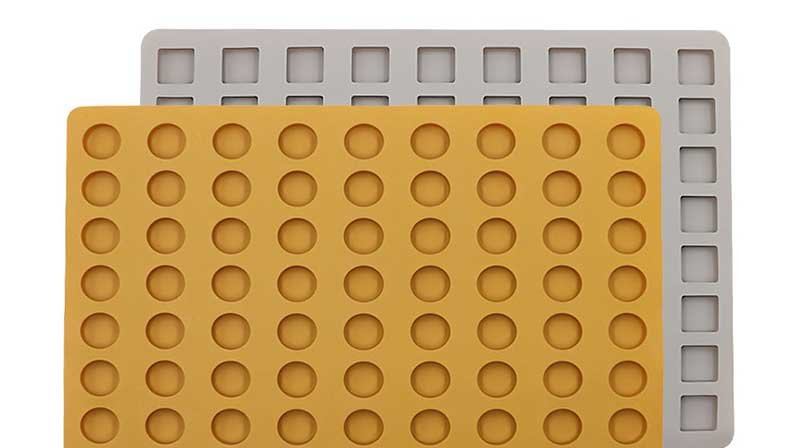Silicone and latex are two elastomeric materials that are widely used in a variety of applications, including industrial, medical, and consumer products. Although they look alike, they are different in many ways. This article will compare these two materials in detail to help readers better understand their properties and applications.
1. Chemical Composition
Silicone
Silicone is a polymer that mainly consists of alternating silicon and oxygen atoms. According to different application requirements, silicone can be processed by different vulcanization methods, including high temperature vulcanization, room temperature vulcanization, and liquid silicone vulcanization. Silicone has a stable molecular structure and possesses strong resistance to high and low temperatures, ultraviolet rays and chemical corrosion.

Latex
The main component of latex is polyisoprene. Latex can be categorized into natural latex and synthetic latex. Natural latex comes from the sap of the rubber tree and contains rubber particles, water, proteins and other compounds. Synthetic latex is made from petrochemicals and comes in a variety of types, including styrene butadiene rubber, nitrile butadiene rubber and polyisoprene. Natural latex has excellent elasticity, but is susceptible to degradation by UV light, ozone and chemicals. Synthetic latex is slightly more durable, but still not as good as silicone.

2. Comparison of Material Properties
| Material | Elasticity and Flexibility | High and Low Temperature Resistance | Weatherability | Chemical Resistance | Water Resistance |
| Silicone Rubber | Excellent | Excellent | Excellent | Excellent | Excellent |
| Natural Latex | Excellent | Fair | Poor | Fair | Poor |
| Synthetic Latex | Good | Fair | Fair | Good | Fair |
(1) Elasticity and flexibility:
Silicone is very elastic and can remain flexible at very low and high temperatures. Usually, it does not lose its elasticity due to temperature changes, so it is suitable for extreme environments.
Both natural and synthetic latex have very good elasticity and flexibility, especially at room temperature. Natural latex maintains a high degree of recovery during stretching, compression and deformation. Synthetic latex is also very flexible, but less so than natural latex.
(2) High and low temperature resistance:
Silicone has excellent high and low temperature resistance. It is usually able to work in the range of -50°C to +230°C without affecting its performance. Some special types can withstand high temperatures up to +300°C or even higher. It also performs well at low temperatures without becoming brittle.

The temperature resistance of natural latex is relatively poor, generally in -20 ° C to +80 ° C temperature range. Beyond this temperature range, natural latex will harden, lose elasticity or become brittle. It is unable to adapt to extreme environments. In contrast, synthetic latexes, especially neoprene, can withstand a much wider range of temperatures. For example, neoprene latex can be stabilized between -30°C and +120°C.
(3) Weatherability:
The weatherability of silicone is very good . It is able to withstand the long-term effects of natural environmental factors such as ultraviolet light, ozone, oxidation, and moisture without aging or becoming brittle. The weatherability makes silicone very suitable for outdoor use.
Natural latex is less resistant to UV, ozone and oxygen. Prolonged exposure to sunlight and air will cause latex to accelerate aging, harden, crack, and lose elasticity. Therefore, natural latex is not suitable for long-term exposure to harsh weather conditions. Synthetic latexes usually outperform natural latexes in terms of weather resistance. Neoprene latex, for example, is highly resistant to ultraviolet rays and ozone, allowing it to be used in outdoor environments without being susceptible to aging or deterioration.
(4) Chemical resistance:
Silicone rubber has excellent chemical resistance. It is resistant to a wide range of acids, alkalis, solvents and other chemicals. It is commonly used in industrial environments for seals, pipe gaskets to withstand corrosive environments.
Natural latex has poor chemical resistance. Especially when exposed to strong acids, alkalis or certain solvents, latex is prone to aging, corrosion or damage. It is not suitable for use in environments that require chemical resistance. The chemical resistance of synthetic latex is usually better, especially neoprene latex, which can withstand stronger acids, alkalis, solvents and other substances.

(5) Water resistance:
Silicone is very resistant to water. It can be used for a long time in wet or underwater environments without being affected.
Natural latex tends to swell in water and is susceptible to moisture. It may lose its elasticity and strength when immersed in water for a long time. So it is not suitable for long-term underwater or humid environment. Synthetic latex is superior to natural latex in terms of water resistance. For example, neoprene latex maintains better elasticity and performance in water-soaked environments.
3.Biocompatibility and Safety
Silicone
Silicone is biocompatible. It contains no harmful substances or irritants and usually does not cause allergic reactions. Besides, silicone is antimicrobial and does not harbor bacteria. This makes it ideal for medical devices, baby products, food containers and other areas where high hygiene standards are required.
Latex
Latex, especially natural latex, can cause allergic reactions, leading to skin irritation, respiratory allergies and other problems. Synthetic latex reduces the risk of allergy, but is not completely allergy-free. For this reason, latex products usually indicate the presence of latex on the packaging. For people with allergies, special care is needed when using latex products. Latex is also relatively weak in antimicrobial properties and can easily become a breeding ground for bacteria.
4.Cost and Productivity
Silicone
Silicone is usually more expensive to produce than latex due to more complex process and expensive raw materials. Silicone products have high requirements for production cycle and technology, making them suitable for specialized markets requiring high performance and long life. Their productivity is also limited by the process, especially for liquid silicone rubber, which requires high-precision equipment and technology.

Latex
Latex is less expensive to produce, especially natural latex. Prices for synthetic latex vary, but are usually cheaper than silicone. Latex is relatively simple to process and has a short production cycle, making it suitable for large-scale production. As a result, latex is often used to produce low-cost consumer products such as disposable gloves, balloons, and mattresses. Latex’s high production efficiency allows it to meet the needs of mass production.

5.Advantages and Disadvantages
Silicone
Advantages
- High durability and resistance to extreme conditions.
- Biocompatible and safe for use in medical and skin contact applications.
Disadvantages
- Higher cost compared to latex.
Latex
Advantages
- High elasticity and excellent tensile properties.
- Cost-effective and widely available.
Disadvantages
- Prone to allergic reactions.
- Poor durability and tends to deteriorate with time and exposure to environmental factors.
6. Applications
Silicone and latex are used in many different areas due to their respective properties.
| Material | Field | Applications | Reason for Use |
| Silicone | Medical | Catheters, implants, medical devices | Biocompatibility, hypoallergenic |
| Household | Baking molds, oven mats, baby products | Heat resistance, ease of cleaning | |
| Industrial | Automotive parts, electronics, construction materials | Extreme temperature resistance, chemical resistance | |
| Latex | Medical | Gloves, catheters, bandages | Elasticity, cost-effectiveness |
| Household | Gloves, balloons, adhesives, textiles | Elasticity, cost-effectiveness | |
| Industrial | Paints, foams, textiles | Flexibility, adhesion properties |

7. Market Trend
Silicone
With the development of science and technology, the application areas of silicone are gradually expanding. In particular, the demand for silicone is increasing in high-performance, medical, and automotive fields. In the future, the market demand for silicone is likely to grow further as the focus on high-performance materials increases.
Latex
The market demand for latex is mainly focused on medical, personal care, and disposable products. Despite its good elasticity and softness, the demand for latex has declined in some markets as concerns over latex allergies have increased. As a result, the growth of the latex market is likely to be somewhat limited in the future, especially against the backdrop of increased health and safety awareness.
Conclusion
Understanding the differences between silicone and latex is essential to making an informed decision based on your specific needs and application. Silicone is durable, hypoallergenic and resistant to extreme conditions, making it ideal for long-term use and medical applications. However, it is more costly. Latex is cost-effective and highly resilient, but it can cause allergic reactions and is less durable. When choosing between silicone and latex, consider the specific requirements of the application to make the best choice.